Woodland Garden Plants
The present-day cultivation of large areas of single annual crops such as wheat might seem, on the surface, to be a very productive and efficient use of land. When other factors are taken into account, however, it can be argued that this is a very unproductive and unsustainable use of the land.
A woodland, on the other hand, might seem to be a very unproductive area for human food (unless you happen to like eating acorns). By choosing the right species, however, a woodland garden can produce a larger crop of food than the same area of wheat, will require far less work to manage it and will be able to be sustainably harvested without harm to the soil or the environment in general.
It is not intended to go into any more details of the pros and cons of annuals versus perennials here - this is discussed in the ‘Why Perennials’ section.
One of the main reasons why a woodland garden can be so productive is that such a wide range of plants can be grown together, making much more efficient use of the land. The greater the diversity of plants being grown together then the greater the overall growth of plant matter there is. Thus you can have tall growing trees with smaller trees and shrubs that can tolerate some shade growing under them. Climbing plants can make their own ways up the trees and shrubs towards the light, and shade-tolerant herbaceous plants and bulbs can grow on the woodland floor.
This page is going to look at some of the many plants that can be grown as part of a woodland garden. A wide range of edible plants are discussed together with brief details of their cultivation needs. Although other details of the plants uses are not mentioned here, it should be realised that woodlands can also provide a wide range of non-food uses. The most obvious is their wood, of course, but they can also provide fibres for cloth and paper, oils, medicines and a whole host of other commodities.
Unless stated otherwise, the plants detailed below are fairly tolerant of most soil types so long as they are not waterlogged. The larger trees and climbers will obviously be able to make their own way up into the sun, the smaller plants will grow well in the dappled shade of the trees unless the text says otherwise.
Forest Garden Videos
Trees and Shrubs.
.jpg) Amelanchier alnifolia. The Juneberry is a small shrub, growing about 6ft tall and suckering to form a thicket. The fruit ripens in mid summer and looks somewhat like a blackcurrant. It is juicy and has a delicious flavour with a hint of apple in the taste. For best yields grow it on the sunny edge of the woodland. Birds absolutely adore this fruit so either grow lots so that there will be some for you, or put a net over the plants just before the fruit is ripe. 4m (13ft) by 3m (9ft)
Amelanchier alnifolia. The Juneberry is a small shrub, growing about 6ft tall and suckering to form a thicket. The fruit ripens in mid summer and looks somewhat like a blackcurrant. It is juicy and has a delicious flavour with a hint of apple in the taste. For best yields grow it on the sunny edge of the woodland. Birds absolutely adore this fruit so either grow lots so that there will be some for you, or put a net over the plants just before the fruit is ripe. 4m (13ft) by 3m (9ft)
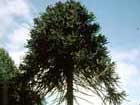
.jpg) Araucaria araucana.The monkey puzzle is a large tree that has the potential of being the highest yielding nut crop that can be grown in temperate climates. A staple food of the native Indians in areas of Chile, the nuts are about the size of an almond and have a very pleasant mild flavour. The main problems with the tree are that it is very slow-growing (it takes about 40 years before it bears its first crop of seeds) and you need to grow both male and female plants in order to obtain the seed. Unfortunately there is no way of telling the sexes apart until they flower and so you need to grow at least 5 trees in order to be fairly sure that you have a mix of the sexes. When grown for its seed, this tree is not really suitable for small areas of land, but if you have the space then why not plant a grove of them to feed future generations? The trees are very wind- resistant and grow best in the wetter warmer areas of the country. 30m (98ft) by 15m (49ft)
Araucaria araucana.The monkey puzzle is a large tree that has the potential of being the highest yielding nut crop that can be grown in temperate climates. A staple food of the native Indians in areas of Chile, the nuts are about the size of an almond and have a very pleasant mild flavour. The main problems with the tree are that it is very slow-growing (it takes about 40 years before it bears its first crop of seeds) and you need to grow both male and female plants in order to obtain the seed. Unfortunately there is no way of telling the sexes apart until they flower and so you need to grow at least 5 trees in order to be fairly sure that you have a mix of the sexes. When grown for its seed, this tree is not really suitable for small areas of land, but if you have the space then why not plant a grove of them to feed future generations? The trees are very wind- resistant and grow best in the wetter warmer areas of the country. 30m (98ft) by 15m (49ft)
.jpg) Caragana arborescens. The Siberian Pea Tree is a very easily grown shrub or small tree. It demands a sunny position, so put it on the sunny edge of the woodland, and it is happier in drier conditions with cold winters. The seed is about the size of a lentil and is usually freely borne. It is best cooked and can be used in all the ways that you normally use cooked beans. 6m (19ft) by 4m (13ft)
Caragana arborescens. The Siberian Pea Tree is a very easily grown shrub or small tree. It demands a sunny position, so put it on the sunny edge of the woodland, and it is happier in drier conditions with cold winters. The seed is about the size of a lentil and is usually freely borne. It is best cooked and can be used in all the ways that you normally use cooked beans. 6m (19ft) by 4m (13ft)
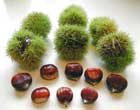 Castanea sativa. Sweet chestnuts are large trees that prefer a well-drained slightly acid loam though they also grow very well in acid infertile sandy soils. Seeds are usually freely produced in temperate climates, though they are seldom as large as the seeds you can buy in shops. There are some named varieties such as “Marron de Lyon”, though you will still not usually obtain quite the same standard of seed as those from shops. This is because the sweet chestnut is really a tree for continental climates and prefers areas with hotter summers than normally experienced in temperate climates. It is at its best in warmer areas and should be given a sunny position. 30m (98ft) by 15m (49ft)
Castanea sativa. Sweet chestnuts are large trees that prefer a well-drained slightly acid loam though they also grow very well in acid infertile sandy soils. Seeds are usually freely produced in temperate climates, though they are seldom as large as the seeds you can buy in shops. There are some named varieties such as “Marron de Lyon”, though you will still not usually obtain quite the same standard of seed as those from shops. This is because the sweet chestnut is really a tree for continental climates and prefers areas with hotter summers than normally experienced in temperate climates. It is at its best in warmer areas and should be given a sunny position. 30m (98ft) by 15m (49ft)
Portuguese 
 Cephalotaxus harringtonia drupacea. The Japanese Plum Yew prefers light soils though it is not too fussy so long as you don’t try and grow it on dry gravelly or chalky soils. It is a medium to large shrub, growing well in the shade of other trees and disliking full sun unless grown in less sunny areas. The fruit is about 3cm long and, when fully ripe is sweet and juicy. It contains a single large oily seed and this is also edible, though it often has a slight bitterness if eaten raw. There are male and female plants, the females produce prolific crops most years if there is one male for about every five females.
Cephalotaxus harringtonia drupacea. The Japanese Plum Yew prefers light soils though it is not too fussy so long as you don’t try and grow it on dry gravelly or chalky soils. It is a medium to large shrub, growing well in the shade of other trees and disliking full sun unless grown in less sunny areas. The fruit is about 3cm long and, when fully ripe is sweet and juicy. It contains a single large oily seed and this is also edible, though it often has a slight bitterness if eaten raw. There are male and female plants, the females produce prolific crops most years if there is one male for about every five females.
5m (16ft) by 3m (9ft)
.jpg) Cornus mas. The Cornelian Cherry is a large shrub or small tree for the sunny edges of a woodland. The oval fruits are ready in late summer and early autumn, when fully ripe they have a pleasant rich flavour. Cornus kousa is a larger tree with fruits that look a bit like a strawberry. Whilst the skin is tough and bitter, the inside is soft and lush with a delicious sweet flavour. Perhaps the easiest way to eat it is to bite a small hole in the skin and then suck out the delectable flesh. The sub-species C. kousa chinensis is said to grow and fruit better in this country. 5m (16ft) by 5m (16ft)
Cornus mas. The Cornelian Cherry is a large shrub or small tree for the sunny edges of a woodland. The oval fruits are ready in late summer and early autumn, when fully ripe they have a pleasant rich flavour. Cornus kousa is a larger tree with fruits that look a bit like a strawberry. Whilst the skin is tough and bitter, the inside is soft and lush with a delicious sweet flavour. Perhaps the easiest way to eat it is to bite a small hole in the skin and then suck out the delectable flesh. The sub-species C. kousa chinensis is said to grow and fruit better in this country. 5m (16ft) by 5m (16ft)
 Corylus species. The British native hazel is a common large shrub of woodlands, succeeding in most soils and in full sun or light shade. The plants flower in early spring and, since the weather is so unpredictable at this time of year, there are years when the crop is extremely poor. If you want to grow the plant for its edible seeds then there are many named varieties available with larger seeds.
Corylus species. The British native hazel is a common large shrub of woodlands, succeeding in most soils and in full sun or light shade. The plants flower in early spring and, since the weather is so unpredictable at this time of year, there are years when the crop is extremely poor. If you want to grow the plant for its edible seeds then there are many named varieties available with larger seeds.
 Crataegus species. The British native hawthorns are not recommended for their fruits, but there are a number of N. American and Asiatic species with very pleasant fruits. These are about the size of a large cherry and contain 5 seeds which usually stick together and are thus effectively like the seed of a cherry. The fruits range in colour from yellow to red and deep purple. In the tastiest species they are juicy and have a very rich flavour. C. arnoldiana has a mealy texture, C. schraderiana is so juicy that it almost melts in the mouth; C. tanacetifolia is crisp and somewhat apple-like. Grow these small trees on the sunny edge of the woodland. 5 to 10m high
Crataegus species. The British native hawthorns are not recommended for their fruits, but there are a number of N. American and Asiatic species with very pleasant fruits. These are about the size of a large cherry and contain 5 seeds which usually stick together and are thus effectively like the seed of a cherry. The fruits range in colour from yellow to red and deep purple. In the tastiest species they are juicy and have a very rich flavour. C. arnoldiana has a mealy texture, C. schraderiana is so juicy that it almost melts in the mouth; C. tanacetifolia is crisp and somewhat apple-like. Grow these small trees on the sunny edge of the woodland. 5 to 10m high
.jpg) Elaeagnus x ebbingei. This is a plant that is commonly grown as a hedge in gardens where it forms an extremely wind- resistant screen 6ft or more high. Left to its own devices it grows about 15ft tall and wide. An extremely tolerant plant, it grows in full sun, deep shade and most soils - its only real dislike is waterlogged soils. The plant flowers in late autumn and ripens its fruit in late Spring, long before the traditional early fruits such as strawberries and unripe gooseberries. When fully ripe these fruits have a delicious rich flavour, their single large seed can also be eaten and has a vague hint of peanut in its taste. This plant is an extremely good companion, helping to enrich the soil with nitrogen and thereby boosting the growth of neighbouring plants. It has been found, for example, that when planted in an orchard it can increase the yields of fruit trees such as plums and nuts by 10%. Not all forms of this plant fruit well, reliable cultivars are being developed, and this plant has the potential to become a commercial crop in the future. 5m (16ft) by 5m (16ft)
Elaeagnus x ebbingei. This is a plant that is commonly grown as a hedge in gardens where it forms an extremely wind- resistant screen 6ft or more high. Left to its own devices it grows about 15ft tall and wide. An extremely tolerant plant, it grows in full sun, deep shade and most soils - its only real dislike is waterlogged soils. The plant flowers in late autumn and ripens its fruit in late Spring, long before the traditional early fruits such as strawberries and unripe gooseberries. When fully ripe these fruits have a delicious rich flavour, their single large seed can also be eaten and has a vague hint of peanut in its taste. This plant is an extremely good companion, helping to enrich the soil with nitrogen and thereby boosting the growth of neighbouring plants. It has been found, for example, that when planted in an orchard it can increase the yields of fruit trees such as plums and nuts by 10%. Not all forms of this plant fruit well, reliable cultivars are being developed, and this plant has the potential to become a commercial crop in the future. 5m (16ft) by 5m (16ft)
 Juglans regia. The walnut is an extremely useful tall-growing tree with edible nuts and many non-food uses. It is rather antisocial in a woodland, however, since it secretes certain substances that inhibit the growth of other plants. Grow at least a couple of trees close to each other to help with fertilization, but do not grow lots of trees close together since this will depress or even prevent the growth of other plants around them. There are many named varieties available with larger fruits - you could try obtaining some of the Polish varieties.
Juglans regia. The walnut is an extremely useful tall-growing tree with edible nuts and many non-food uses. It is rather antisocial in a woodland, however, since it secretes certain substances that inhibit the growth of other plants. Grow at least a couple of trees close to each other to help with fertilization, but do not grow lots of trees close together since this will depress or even prevent the growth of other plants around them. There are many named varieties available with larger fruits - you could try obtaining some of the Polish varieties.
20m (65ft) by 20m (65ft)

.jpg)
 Malus sylvestris/ domestica. This is the cultivated apple. It is not intended to go into details of the common fruits in this chapter, other than to say that apples make excellent small or large trees (depending on rootstock used) for the sunny side of woodland gardens.
Malus sylvestris/ domestica. This is the cultivated apple. It is not intended to go into details of the common fruits in this chapter, other than to say that apples make excellent small or large trees (depending on rootstock used) for the sunny side of woodland gardens.
Up to 9m (30ft)
Prunus species. This genus contains the cultivated plums and cherries, both excellent plants for a sunny position in a woodland garden.
1.5m to 7m
Pyrus communis. Pears are another commonly cultivated fruit for sunny areas in the woodland.
5m (16ft)
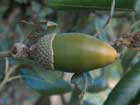 Quercus ilex. The holm or holly oak is a large spreading, but slow-growing, evergreen tree. Very tolerant of maritime exposure, it will in time offer a high degree of shelter from the elements, though its dense shade will severely limit what can grow underneath it. The seed is rather smaller than British native acorns, but unlike them it is very often free of bitter tannins and can be eaten raw or cooked like sweet chestnuts. Trees usually fruit very well in temperate climates. The sub- species Q. ilex ballota has been cultivated in south-western Europe for its sweet-tasting seeds, though it is not such a reliable cropper in temperate regions.
Quercus ilex. The holm or holly oak is a large spreading, but slow-growing, evergreen tree. Very tolerant of maritime exposure, it will in time offer a high degree of shelter from the elements, though its dense shade will severely limit what can grow underneath it. The seed is rather smaller than British native acorns, but unlike them it is very often free of bitter tannins and can be eaten raw or cooked like sweet chestnuts. Trees usually fruit very well in temperate climates. The sub- species Q. ilex ballota has been cultivated in south-western Europe for its sweet-tasting seeds, though it is not such a reliable cropper in temperate regions.
25m (82ft) by 20m (65ft)
.jpg) Ribes species. This genus includes the cultivated gooseberries and currants, all of which are excellent small shrubs for the sunny edges of a woodland or for light shade.
Ribes species. This genus includes the cultivated gooseberries and currants, all of which are excellent small shrubs for the sunny edges of a woodland or for light shade.
1m to 2.5m
.jpg) Rubus species. This includes the cultivated blackberries and raspberries, both of which are excellent woodland plants in sun or light shade. There are also a number of N. American species of raspberries, including R. deliciosus, R. leucodermis, R. occidentalis, R. parviflorus and R. spectabilis that also do very well in the woodland. They need a warm fairly sunny position if they are to fruit well. The flavour develops better in a good summer. R. phoenicolasius, the Japanese wineberry, is a very ornamental raspberry from Asia. Its fruits are about half the size of cultivated raspberries but the have a lovely flavour and are virtually free of maggot damage since the developing fruit is enveloped in the calyx until just before it comes ripe.
Rubus species. This includes the cultivated blackberries and raspberries, both of which are excellent woodland plants in sun or light shade. There are also a number of N. American species of raspberries, including R. deliciosus, R. leucodermis, R. occidentalis, R. parviflorus and R. spectabilis that also do very well in the woodland. They need a warm fairly sunny position if they are to fruit well. The flavour develops better in a good summer. R. phoenicolasius, the Japanese wineberry, is a very ornamental raspberry from Asia. Its fruits are about half the size of cultivated raspberries but the have a lovely flavour and are virtually free of maggot damage since the developing fruit is enveloped in the calyx until just before it comes ripe.
3m (9ft 10in)
 Tilia x europaea. The British native lime trees possibly have the best tasting leaves from a tree. They can be used in salads, replacing lettuces, which can be difficult to grow. Only the young leaves should be used, though these can be produced from spring to autumn from the sucker growth that is often found at the base of the trees. T. cordata and T. platyphyllos are other British natives and can also be used.
Tilia x europaea. The British native lime trees possibly have the best tasting leaves from a tree. They can be used in salads, replacing lettuces, which can be difficult to grow. Only the young leaves should be used, though these can be produced from spring to autumn from the sucker growth that is often found at the base of the trees. T. cordata and T. platyphyllos are other British natives and can also be used.
35m (114ft) by 15m (49ft)
Climbing plants.
 Actinidia deliciosa. The Kiwi fruit has become relatively well known in recent years, though many people do not realise that it can fruit very heavily when grown in temperate climates. A very vigorous climber, it can either be grown on a frame or into a large mature tree (though harvesting fruit 70ft or more above the ground can be quite a problem). Try to place the plant on the south-western side of the garden so that it gets plenty of sun during the day, but is sheltered from early morning sun, since the young growth in spring can be damaged by frosts.
Actinidia deliciosa. The Kiwi fruit has become relatively well known in recent years, though many people do not realise that it can fruit very heavily when grown in temperate climates. A very vigorous climber, it can either be grown on a frame or into a large mature tree (though harvesting fruit 70ft or more above the ground can be quite a problem). Try to place the plant on the south-western side of the garden so that it gets plenty of sun during the day, but is sheltered from early morning sun, since the young growth in spring can be damaged by frosts.
9m (29ft 6in)
 Apios americana.This is an herbaceous climbing plant with a delicious edible root that can be eaten raw, but is best baked. Grow it on the sunny side of the woodland and either give it supports or let it climb into small shrubs. Yields of the wild species are fairly low, but new cultivars are being developed with much higher yields and this plant might become commercially cultivated in the future. (One correspondent on the PFAF site says that this plant has some “anti nutritional factors, such as trypsin inhibitors ... so it should be cooked before being eaten”)
Apios americana.This is an herbaceous climbing plant with a delicious edible root that can be eaten raw, but is best baked. Grow it on the sunny side of the woodland and either give it supports or let it climb into small shrubs. Yields of the wild species are fairly low, but new cultivars are being developed with much higher yields and this plant might become commercially cultivated in the future. (One correspondent on the PFAF site says that this plant has some “anti nutritional factors, such as trypsin inhibitors ... so it should be cooked before being eaten”)
1.2m (4ft)
 Humulus lupulus. The British native hop can climb to a height of 20 feet and succeeds in sun or semi-shade. The young shoots can be eaten in the spring, you harvest them when they are about 1 ft long and cook them like asparagus. The flavour is said to be unique and some people find it delicious. Female plants produce a cone-like seed head that is used as the bitter flavouring and preservative in beer.
Humulus lupulus. The British native hop can climb to a height of 20 feet and succeeds in sun or semi-shade. The young shoots can be eaten in the spring, you harvest them when they are about 1 ft long and cook them like asparagus. The flavour is said to be unique and some people find it delicious. Female plants produce a cone-like seed head that is used as the bitter flavouring and preservative in beer.
This seed head is also widely used as a medicinal herb; its sedative properties make it an ideal material to stuff pillows with since it aids restful sleep.
6m (19ft 8in)
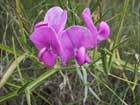 Lathyrus tuberosus. Lathyrus tuberosus Earthnut Pea
Lathyrus tuberosus. Lathyrus tuberosus Earthnut Pea
This low-growing herbaceous climber produces small black tubers that are absolutely delicious baked. Unfortunately the yields are rather low but since it can be grown along the woodland edge below other productive plants (and also helps to enrich the soil with nitrogen) then its harvest can be viewed as a very tasty bonus from the land.
1.2m (4ft)
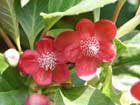 Schisandra grandiflora/ rubriflora. This deciduous climber grows about 20ft tall and produces bunches of small red fruits looking somewhat like small loose bunches of grapes. The fruits are about a third of an inch in diameter and have a delicious sweet flavour. Grow it in semi-shade in a slightly acid soil, though it will succeed in slightly alkaline soils if lots of organic matter is added.
Schisandra grandiflora/ rubriflora. This deciduous climber grows about 20ft tall and produces bunches of small red fruits looking somewhat like small loose bunches of grapes. The fruits are about a third of an inch in diameter and have a delicious sweet flavour. Grow it in semi-shade in a slightly acid soil, though it will succeed in slightly alkaline soils if lots of organic matter is added.
6m (19ft 8in)
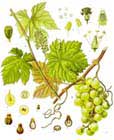 Vitis vinifera. Grapes are well enough known, so they are not given much space here. If you live in the warmer parts of the country then you could try growing them along the sunny edge of the woodland.
Vitis vinifera. Grapes are well enough known, so they are not given much space here. If you live in the warmer parts of the country then you could try growing them along the sunny edge of the woodland.
15m (49ft)
Other perennial species.
.jpg) Allium ursinum. The native wild garlic grows abundantly in hedgerows and woods. It comes into growth in mid to late winter and the leaves can be eaten raw or cooked. They have a very pleasant mild garlic flavour and add a zest to salads at this time of the year. The flowers and small bulbs can also be used. A. triquetrum, the three-cornered leek grows well on the sunnier edges of the woodland. These plants come into growth in the autumn and can supply their leaves throughout the winter. (See the page on Wild Garlic for more information about this plant.)
Allium ursinum. The native wild garlic grows abundantly in hedgerows and woods. It comes into growth in mid to late winter and the leaves can be eaten raw or cooked. They have a very pleasant mild garlic flavour and add a zest to salads at this time of the year. The flowers and small bulbs can also be used. A. triquetrum, the three-cornered leek grows well on the sunnier edges of the woodland. These plants come into growth in the autumn and can supply their leaves throughout the winter. (See the page on Wild Garlic for more information about this plant.)
0.3m (1ft) by 0.3m (1ft)
 Campanula persicifolia. This Harebell (or bluebell if you live in Scotland) is a beautiful plant that produces a flowering stem about 3 ft tall in the summer. The flowers have a delicate sweet flavour and make a very attractive addition to the salad bowl. The mild-flavoured leaves can be harvested for about 9 months of the year and used in salads.
Campanula persicifolia. This Harebell (or bluebell if you live in Scotland) is a beautiful plant that produces a flowering stem about 3 ft tall in the summer. The flowers have a delicate sweet flavour and make a very attractive addition to the salad bowl. The mild-flavoured leaves can be harvested for about 9 months of the year and used in salads.
1m (3ft 3in) by 0.5m (1ft 8in)
.jpg) Cryptotaenia japonica. Japanese Parsley is not really a parsley, but the leaves taste vaguely like it if you use a considerable amount of imagination. All other parts of the plant can also be eaten, the seeds being used as a flavouring, the stem used as a celery substitute and the root eaten raw or cooked. The plant grows about 3 feet tall and prefers a moist shady position under trees, where it will often self-sow. Keep it away from slugs, though, because they will decimate it.
Cryptotaenia japonica. Japanese Parsley is not really a parsley, but the leaves taste vaguely like it if you use a considerable amount of imagination. All other parts of the plant can also be eaten, the seeds being used as a flavouring, the stem used as a celery substitute and the root eaten raw or cooked. The plant grows about 3 feet tall and prefers a moist shady position under trees, where it will often self-sow. Keep it away from slugs, though, because they will decimate it.
1m (3ft) by 0.6m (2ft)
.jpg) Erythronium species. Dog’s Tooth Violets are dainty low-growing woodland bulbs related to lilies. They flower in early spring and disappear completely by early summer. The bulbs can be eaten raw or cooked and have a pleasant, sweet flavour. Any of the species can be used; the cultivars “Pagoda” and “White Beauty” are easy to grow and increase freely.
Erythronium species. Dog’s Tooth Violets are dainty low-growing woodland bulbs related to lilies. They flower in early spring and disappear completely by early summer. The bulbs can be eaten raw or cooked and have a pleasant, sweet flavour. Any of the species can be used; the cultivars “Pagoda” and “White Beauty” are easy to grow and increase freely.
0.2m (0ft 8in) by 0.1m (0ft 4in)
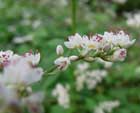 Fagopyrum dibotrys. Perennial Buckwheat is a very vigorous plant for light shade in the woodland. It can grow 2 metres tall and spreads freely when well placed. The leaves can be cooked and eaten like spinach, for which they make an acceptable, though not inspiring, substitute. The leaves, however, are a good source of rutin and this can have a very beneficial effect on the circulatory system - it is used in the treatment of arteriosclerosis, high blood pressure and rheumatism, for example.
Fagopyrum dibotrys. Perennial Buckwheat is a very vigorous plant for light shade in the woodland. It can grow 2 metres tall and spreads freely when well placed. The leaves can be cooked and eaten like spinach, for which they make an acceptable, though not inspiring, substitute. The leaves, however, are a good source of rutin and this can have a very beneficial effect on the circulatory system - it is used in the treatment of arteriosclerosis, high blood pressure and rheumatism, for example.
1m (3ft) by 2m (6ft)
.jpg) Lilium species. Lilies are ideal plants for the woodland. Although it might seem a sacrilege, some lily species are cultivated for their edible bulbs (the growers actually prevent the plant from flowering so that it puts more energy into the bulb). If you ever find that you have too many of any particular species then you could always try eating a few bulbs. If you want to cultivate plants for their bulbs, try the tiger lily, L. lancifolium.
Lilium species. Lilies are ideal plants for the woodland. Although it might seem a sacrilege, some lily species are cultivated for their edible bulbs (the growers actually prevent the plant from flowering so that it puts more energy into the bulb). If you ever find that you have too many of any particular species then you could always try eating a few bulbs. If you want to cultivate plants for their bulbs, try the tiger lily, L. lancifolium.
1m (3ft)
 Montia sibirica. Miner’s Lettuce is an evergreen herbaceous plant that succeeds in deep shade as well as in the sunnier areas. A short-lived perennial, it usually self-sows freely and makes an excellent ground cover in the woodland. The leaves can be harvested for salads all the year round and the flowers can also be used.
Montia sibirica. Miner’s Lettuce is an evergreen herbaceous plant that succeeds in deep shade as well as in the sunnier areas. A short-lived perennial, it usually self-sows freely and makes an excellent ground cover in the woodland. The leaves can be harvested for salads all the year round and the flowers can also be used.
0.2m (8in)
.jpg) Myrrhis odorata. Sweet Cicely has delicious aniseed-flavoured leaves that are available from late winter until early the next winter. This herbaceous perennial prefers moister soils and is a native plant that is well able to look after itself.
Myrrhis odorata. Sweet Cicely has delicious aniseed-flavoured leaves that are available from late winter until early the next winter. This herbaceous perennial prefers moister soils and is a native plant that is well able to look after itself.
1m (3ft) by 1m (3ft)
.jpg) Rumex acetosa. Ken Fern grew a form of sorrel that virtually never flowered and produced lemon-flavoured leaves all twelve months of the year. However, you cannot eat sorrel in large quantities because it contains oxalic acid (which is what gives it the lemon flavour) and this can bind up certain of the nutrients in food, making them unavailable to the body. In moderate amounts, however, it is a very tasty and nutritious food. Grow it in the sunnier parts of the woodland.
Rumex acetosa. Ken Fern grew a form of sorrel that virtually never flowered and produced lemon-flavoured leaves all twelve months of the year. However, you cannot eat sorrel in large quantities because it contains oxalic acid (which is what gives it the lemon flavour) and this can bind up certain of the nutrients in food, making them unavailable to the body. In moderate amounts, however, it is a very tasty and nutritious food. Grow it in the sunnier parts of the woodland.
0.6m (2ft) by 0.3m (1ft)
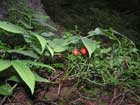 Streptopus amplexifolius. Wild Cucumber grows very well in the cool shade of a woodland where it can reach a height of 3 feet. Its fruit can be eaten raw or cooked and is juicy with a cucumber flavour. Do not eat it in large quantities at your first try since it can be laxative until your body gets used to it. The young shoots can be eaten raw in salads or cooked like asparagus and also have a cucumber-like flavour, and the root is sometimes used in salads and also has a cucumber flavour.
Streptopus amplexifolius. Wild Cucumber grows very well in the cool shade of a woodland where it can reach a height of 3 feet. Its fruit can be eaten raw or cooked and is juicy with a cucumber flavour. Do not eat it in large quantities at your first try since it can be laxative until your body gets used to it. The young shoots can be eaten raw in salads or cooked like asparagus and also have a cucumber-like flavour, and the root is sometimes used in salads and also has a cucumber flavour.
1m (3ft) by 0.3m (1ft)
.jpg) Urtica dioica. Stinging nettles are well enough known to anyone who has had a brush with them. Surprisingly few people, however, know that the leaves are edible when cooked, are highly nutritious and are also very tasty. Harvest the young shoot tips in spring and early summer - if you want to harvest them later in the year then cut down a patch to encourage fresh growth. Do not eat the older shoots since these can develop substances that are an irritant to the kidneys. Wear gloves when harvesting the leaves to avoid being stung -when cooked the leaves lose all of their ability to sting. Raw leaves can be used in a pesto instead of basil.
Urtica dioica. Stinging nettles are well enough known to anyone who has had a brush with them. Surprisingly few people, however, know that the leaves are edible when cooked, are highly nutritious and are also very tasty. Harvest the young shoot tips in spring and early summer - if you want to harvest them later in the year then cut down a patch to encourage fresh growth. Do not eat the older shoots since these can develop substances that are an irritant to the kidneys. Wear gloves when harvesting the leaves to avoid being stung -when cooked the leaves lose all of their ability to sting. Raw leaves can be used in a pesto instead of basil.
1.2m (4ft) by 1m (3ft)
.jpg) Viola odorata. Sweet Violet is a low-growing carpeting plant that provides mild-flavoured edible leaves all the year round and deliciously sweet edible flowers throughout the winter. A British native plant, it is quite capable of looking after itself along the woodland edge.
Viola odorata. Sweet Violet is a low-growing carpeting plant that provides mild-flavoured edible leaves all the year round and deliciously sweet edible flowers throughout the winter. A British native plant, it is quite capable of looking after itself along the woodland edge.
0.1m (4in) by 0.5m (1.5ft)
Database
The database has more details on these plants: Actinidia deliciosa, Allium ursinum, Amelanchier alnifolia, Apios americana, Araucaria araucana, Campanula persicifolia, Caragana arborescens, Castanea sativa, Cephalotaxus harringtonia, Cephalotaxus harringtonia drupacea, Cornus kousa, Cornus mas, Cryptotaenia japonica, Elaeagnus x ebbingei, Fagopyrum dibotrys, Humulus lupulus, Juglans regia, Lathyrus tuberosus, Malus sylvestris, Myrrhis odorata, Pyrus communis, Quercus ilex, Rubus deliciosus, Rubus leucodermis, Rubus occidentalis, Rumex acetosa, Rumex occidentalis, Schisandra grandiflora, Schisandra rubriflora, Streptopus amplexifolius, Tilia cordata, Tilia platyphyllos, Tilia x europaea, Urtica dioica, Viola odorata, Vitis vinifera.